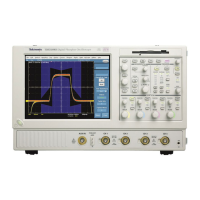TDS5000B Online Programmer Guide
-- 1 7 9 --
CURVe
Description
This command transfers waveform data to and from the instrument.
Each waveform that is transferred has an associated waveform
preamble that contains information such as data format and scale.
The CURVe? query transfers data from the instrument. The data source
is specified by the DATa:SOUrce command. The first and last data
points are specified by the DATa:STARt and DATa:STOP commands.
The CURVe command transfers waveform data to the instrument. The
data is stored in the reference memory location specified by
DATa:DESTination, starting with the data point specified by
DATa:STARt. Only one waveform can be transferred at a time. The
waveform will only be displayed if the reference is displayed.
Group
Waveform Transfer
Related Commands
DATa:DESTination, DATa:SOUrce, DATa:STARt, DATa:STOP,
SAVe:WAVEform, SAVe:WAVEform:FILEFormat, WFMInpre,
WFMInpre:BYT_Nr, WFMOutpre, WFMInpre:NR_FR?,
WFMOutpre:NR_FR?
Syntax 1
CURVe {<Block>|<asc curve>}
Syntax 2
CURVe?
Arguments
H <Block>
This is the waveform data in binary format. The waveform is for-
matted as: #<x><yyy><data><newline>, where
<x> is the number of y bytes. For example, if <yyy>=500, then
<x>=3)
<yyy> is the number of bytes to transfer. If width is 1, then all bytes
on the bus are single data points. If width is 2, then all bytes on the
bus are 2--byte pairs. If width is 4, then all bytes on the bus are 4--byte
pairs. Use the WFMInpre:BYT_Nr command to set the width.
<data> is the curve data.
<newline> is a single byte new line character at the end of the data.
H <asc curve>
This is the waveform data in ASCII format. The format for ASCII
data is <NR1>[,<NR1>…], where each <NR1> represents a data
point.

